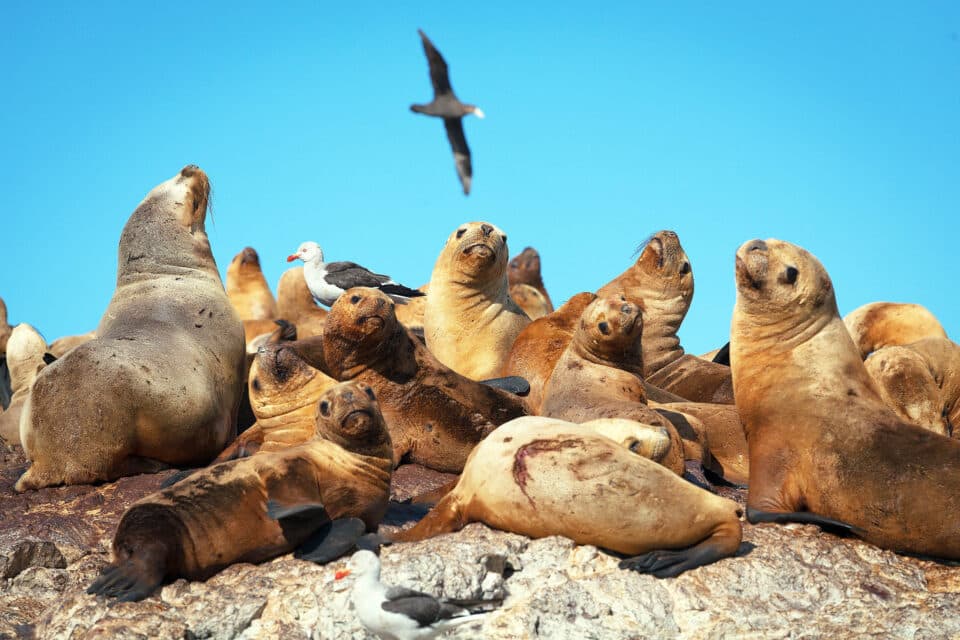
Avian influenza is spreading globally from birds to marine mammals
The emergence of the H5N1 avian influenza virus in marine environments, a pathogen capable of crossing species barriers, has raised significant concerns within the wildlife conservation community.
A recent collaborative study by the University of California, Davis, and the National Institute of Agricultural Technology (INTA) in Argentina has shed light on the virus’s adaptation and its implications for both marine and bird populations along the Atlantic coast of South America.
H5N1 avian influenza strikes marine life
Researchers focused their investigation on a collection of brain samples from deceased sea lions, a fur seal, and a tern found in Argentina’s most affected sea lion rookery.
The analysis confirmed H5N1 infection in all specimens, revealing a near-identical virus sequence across the samples.
This uniformity included specific mutations known for mammalian adaptation, previously identified in marine mammals and a human case across Peru and Chile, and, notably, in a tern for the first time.
Agustina Rimondi, a virologist from INTA and the study’s first author, emphasized, “This confirms that while the virus may have adapted to marine mammals, it still has the ability to infect birds. It is a multi-species outbreak.”
Dire implications of H5N1’s marine mammal mutation
The presence of mammal-adaptation mutations in the tern’s virus sequence highlights the potential for transmission between marine mammals.
Despite these findings, Marcela Uhart, a senior author and wildlife veterinarian at the UC Davis School of Veterinary Medicine, reassures that the virus currently poses a relatively low risk to humans.
However, she warns of the potential for increased concern if the virus continues to replicate in mammals. Uhart underscores the importance of ongoing surveillance and early warning efforts to mitigate this risk.
Tracing the path of H5N1
Labelled as “this new monster” by Uhart, the clade 2.3.4.4b variant of H5N1 emerged in 2020 amidst the global COVID-19 pandemic, initially impacting sea birds in Europe before spreading to South Africa, and then to the Americas, threatening poultry and wild bird populations.
By February 2023, the virus had reached Argentina, demonstrating its lethal potential by August 2023 among sea lions at Tierra del Fuego’s Atlantic coastline, and then moving northward with devastating effects on marine mammals and seabirds alike.
A staggering toll has been observed, with at least 600,000 wild birds and 50,000 mammals, including elephant seals and sea lions across Argentina, Chile, and Peru, as well as thousands of albatrosses in the Malvinas/Falkland Islands, succumbing to the virus.
A significant outbreak documented by Uhart and her team resulted in a 70% mortality rate among newborn elephant seal pups during the 2023 breeding season in Argentina’s Península Valdés.
Avian influenza marching towards Antarctic marine life
The virus’s southward trajectory towards Antarctica has prompted urgent wildlife surveillance efforts by Uhart and her colleague Ralph Vanstreels, aimed at assessing the risk to previously unexposed species.
The potential consequences of such exposure could be dire, necessitating a vigilant approach to monitoring and prevention.
The study embodies the One Health concept, recognizing the interconnectedness of human, domestic animal, wildlife, and environmental health. It calls for a unified response from public, wildlife, agricultural, and health sectors worldwide to address the challenges posed by interspecies disease outbreaks.
In concluding remarks, Uhart reflects on the necessity of giving a voice to affected wildlife populations, highlighting the importance of long-term observational data and global collaboration in preparing for future challenges.
“We are trying to be at the forefront of documenting, recording, and providing early warning,” she states, emphasizing the critical role of scientific and conservation efforts in addressing the sprawling impact of the H5N1 virus.
Global consequences of H5N1 in the wild
In summary, this disturbing study by the University of California, Davis has illuminated a critical shift in the behavior of the H5N1 avian influenza virus, revealing its newfound ability to infect and spread among marine mammals, alongside its traditional avian hosts.
Their research underscores the virus’s escalating threat to global wildlife conservation while highlighting the imperative for heightened surveillance and international collaboration to mitigate its spread.
By tracing the genomic footprints of H5N1 across species and continents, scientists offer a clarion call to action, urging a unified approach to safeguard the health of our planet’s diverse ecosystems against this formidable viral foe.
More about H5N1 avian influenza
The H5N1 avian influenza virus, commonly known as bird flu, represents a significant threat to both avian and human populations worldwide.
Identified initially in 1959 during an outbreak in Scottish chickens, H5N1 has since evolved into a highly pathogenic strain that inflicts severe respiratory disease in birds and poses a zoonotic risk to humans.
Transmission and spread
H5N1 primarily affects birds, both wild and domestic, with waterfowl and poultry being particularly susceptible. The virus transmits through direct contact with infected animals, their secretions, or contaminated environments. Notably, migratory birds play a crucial role in spreading the virus across continents, facilitating outbreaks that can decimate poultry industries and threaten food security.
Human cases of H5N1 infection are rare but have occurred, primarily among individuals with close contact with infected birds or contaminated environments. Human-to-human transmission remains extremely limited, but the potential for the virus to evolve and gain this capability is a source of global concern.
Symptoms and treatment
In birds, H5N1 causes severe respiratory problems, leading to high mortality rates. Symptoms in infected birds include sudden death, uncoordinated movement, and decreased egg production.
In humans, H5N1 infection can cause severe respiratory illness, including pneumonia. Symptoms often begin as typical flu-like symptoms but can rapidly progress to severe respiratory distress and other complications. Treatment typically involves antiviral medications, and early intervention is crucial for improving outcomes.
Prevention and control measures
Preventing H5N1 spread involves rigorous biosecurity measures, including surveillance of poultry farms, culling infected animals, and vaccinating poultry.
Public health initiatives focus on reducing human exposure to infected birds, improving hygiene practices, and preparing for potential pandemics through vaccine development and strategic planning.
Implications and future study
The H5N1 avian influenza virus remains a potent threat to global health and economy, necessitating ongoing vigilance, research, and cooperation among nations to mitigate its impact.
While primarily an avian disease, its potential to evolve and spread among humans underscores the importance of preparedness and response strategies to protect public health.
The full study was published in the journal Emerging Infectious Diseases.
—–
Like what you read? Subscribe to our newsletter for engaging articles, exclusive content, and the latest updates.
Check us out on EarthSnap, a free app brought to you by Eric Ralls and Earth.com.
—–












